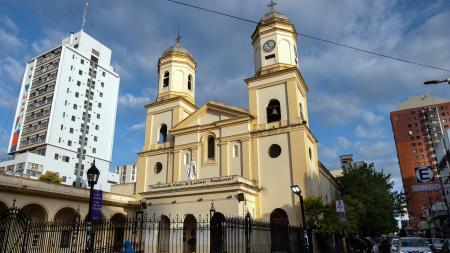A total of 59 cathedrals are distributed throughout the countrys, each with its own architectural style and the peculiarity of having been key in the formation of the municipalities where they are located.
In the metropolitan area of Buenos Aires, the cathedrals of the parties of San Isidro, Quilmes and Lomas de Zamoraare the most representative for the stories they have gathered since their foundation and for the architectural style with which they were built.
The Cathedral of San Isidro, located at 16200 Libertador Avenue, was inaugurated on May 27, 1708, by Domingo de Acassuso and whose first parish priest was the priest Fernando Ruiz-Corredor.
Pedro Oeyen, parish priest emeritus and historian of the temple, told Télam that “the name of the cathedral is due to the fact that the promoter of the initiative (Domingo Acassuso) was a devotee of San Isidro”


Oeyen pointed out that the first building “was made of bricks and a tiled roof, of meager proportions and in a context where it was all fields and the population was scarce and scattered.”
In 1895, the first cathedral of San Isidro was demolished due to structural problems and the current religious building was built on the same property, which was inaugurated in 1898.
The Cathedral of Santiago del Estero, the first in the country, preserves images from the 16th and 17th centuries
✍ Maria Soledad Gonzalezhttps://t.co/0VzNI3ks5I
—Telam Agency (@TelamAgency) October 18, 2022
In the municipality of Quilmesis the Immaculate Conception Cathedrallocated Peatonal Rivadavia 349, whose first building was built in 1685 by Juan de Zeballos, mayor of the town of Santa Cruz de los Quilmes.
According to historian Jorge Márquez, “it was built at the time of the reduction of the Quilmes Indians, with the aim of evangelizing and in addition to having cheap labor”.
He indicated that the first building was built in a rudimentary manner with the peculiarity that “the materials used lasted a maximum of 30 years.”
In Lomas de zamoraone of the founding buildings is the cathedral known as “Our Lady Peace“, located at 438 Antonio Sáenz Street, whose construction began in 1860, in an act that the then governor Bartolomé Miter participated, together with the canon, Gabriel Fuentes.
Margarita Casas, a member of the Municipal Historical Institute of Lomas de Zamora, explained that the initial construction of the temple began with the Genoese architects Nicolás and José Canale. Who after intense work managed to inaugurate part of the parish five years “

In this sense, he highlighted the role of Juana Zorrilla de Grigera, who “brought a religious figure of a sculpted virgin from Spain, which currently remains in the building”.
These cathedrals followed various European aesthetic movements, although adapted to the materials and characteristics of the place.
A total of 59 cathedrals are distributed throughout the country, each with its own architectural style and the peculiarity of having been key in the formation of the municipalities where they are located.
“The Cathedral of San Isidro has the lines of the Gothic, which was an artistic movement of the 14th and 15th centuries, but with materials that are far from being the same as those European buildings, because bricks, cement and masonry were used for this building”, Oeyen described.

Along the same lines, the Quilmes Cathedral also followed the Baroque architectural style, an artistic movement that existed between the 17th and 18th centuries.
“The current design of the cathedral is similar to the Gesú cathedral in Rome, Italy. Although inside and around it it differs from other religious buildings. At the entrance of the cathedral there are tombs, because that area was part of the first cemetery Marquez pointed out.
While the cathedral of Lomas de Zamora was designed following an Italian neo-Renaissance architectural style, an artistic movement of the 19th century.
“The design of the building has three naves with four sections and a Latin cross transept, a classical façade with one door per nave,” said Casas.
Oeyen pointed out that the tower of the San Isidro cathedral was a point of reference for the ships that sailed on the Río de la Plata.
“When the chapel was built, this was all fields, where low houses predominated, so it was a point of reference that could be seen from the city of Buenos Aires, especially for the nautical sector. The tower is 68 meters high, which also has beacons that river navigation always use,” emphasized Oeyen.
Márquez commented that the tower of the cathedral was the place of historical events not only for the town in southern Buenos Aires, but also for the history of the country.
“The bells of the cathedral gave notice to the population of Quilmes about the arrival of the first English invasion,” said Márquez.
And he added “in 1872, when the first railway arrived in the municipality, the residents and local authorities climbed to the top of the tower to see the arrival of the transport.”















